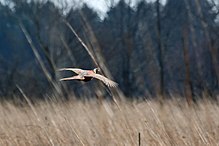Pheasantry
A pheasantry , pheasant chamber or pheasant garden is an enclosure in which pheasants are kept. It is often spacious and adapted to the animals' habitat.
nature
These facilities for maintaining the pheasant population are divided into
- tame pheasantries and
- wild pheasantries.
In tame pheasantries, the laying and breeding of turkeys and brood hens is monitored and there are regulatory interventions by isolating the breeders. In wild pheasantries, the animals are largely left to their own devices, but the keeper (mostly the forest workers) ensures that the natural enemies are reduced.
The Pierer Lexicon of 1857 writes regarding the nature and requirements of a pheasantry: “A good pheasantry includes:
- flat or south-facing, not too cold location,
- bigger u. smaller damp to wet surfaces,
- Bushwood with berries, meadows, fields, water, protection against cold winds;
- Surroundings of woodwork or walls,
- Traps for beasts of prey. "
So-called pheasant chambers are still an occasional practice today to naturalize pheasants in a biotope. For this purpose, a large piece of land is fenced in so that it is protected from predatory game and pheasants are kept in it. The aim is for them to raise offspring undisturbed here and to leave the chamber each time they are able to fly and populate the hunting ground. Suitable chambers have some trees that are not too high and suitable for tree growth, a piece of freshly moist meadow and water in the form of a stream or ditch or a small, non-drying pond.
development
Pheasantries have existed in Germany since the end of the 17th century. Here they served the nobility mainly as a destination populated with beautiful birds , see also the menagerie . For this reason, peacocks were also often introduced . During and especially after the Second World War , the pheasant stocks were severely decimated (the cause is assumed to be, in addition to the consequences of the war, also the population's shortage of food). In order to compensate for these losses, numerous state hunting associations decided in 1950/51 to set up various rearing pheasantries.
Some local recreation areas of cities still bear the name pheasantry in reference to their earlier function , although one only rarely comes across a specimen of this genus there.
Well-known pheasantries
Germany
- Alte Fasanerie wildlife park near Klein-Auheim
- Alte Fasanerie wildlife park near Hanau
- Groß-Gerau pheasantry at Dornberg Castle in Groß-Gerau
- Pheasantry in Aschaffenburg
- Fasanerie animal and plant park in Wiesbaden
- Fasanerie-Nord , a district in the north of Munich
- Fasanerie (Darmstadt)
- Fasanerie in Zweibrücken, see Tschifflick pleasure palace
Poland
- Pheasantry in Poremba , Silesia
France
- Wilde Fasanerie, park of the Rohan Castle near Zabern , today " La Faisanderie " in French , was laid out in the 18th century instead of a zoo.
literature
- Hans Behnke, Günter Claussen: Pheasant and Partridge. Biology, Hege, Aufzucht , Franckh-Kosmos Verlag, Stuttgart 2007, ISBN 978-3-440-10917-5
- Elisabeth Herget, Werner Busch: Fasanerie , in: Reallexikon zur Deutschen Kunstgeschichte , Vol. 7, 1975, Col. 437–461
Web links
Individual evidence
- ↑ http://www.retrobibliothek.de/retrobib/seite.html?id=105503
- ↑ Pheasantry . In: Heinrich August Pierer , Julius Löbe (Hrsg.): Universal Lexicon of the Present and the Past . 4th edition. tape 6 . Altenburg 1858, p. 125 ( zeno.org ).
- ↑ Behnke and Claussen, p. 60
- ↑ cf. fr: Faisanderie (Saverne)
- ↑ Ambroise Firmin Didot, "Panorama pittoresque de la France ...: les principales villes, les ports de mer, les établissements d'eaux minérales et les chateaux pittoresques, les édifices, monuments, sites remarquables", Verlag Firmin-Didot, 1839 , Volume 5, Paris, p. 17
